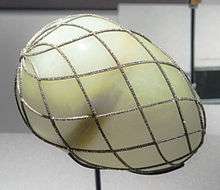Diamond Trellis (Fabergé egg)
The Diamond Trellis egg is a jewelled enameled Easter egg made by August Holmström under the supervision of the Russian jeweller Peter Carl Fabergé in 1892.[1] It is one of the Imperial Fabergé eggs, made for Alexander III of Russia, who presented it to his wife, the Empress Maria Feodorovna. The egg is owned by an American couple, Artie and Dorothy McFerrin, and is on display at the Houston Museum of Natural Science.[2]
| Diamond Trellis Fabergé egg | |
|---|---|
 | |
| Year delivered | 1892 |
| Customer | Alexander III |
| Recipient | Maria Feodorovna |
| Current owner | |
| Individual or institution | Artie and Dorothy McFerrin |
| Design and materials | |
| Workmaster | August Holmström |
| Materials used | Gold, jadeite, rose-cut diamonds |
| Height | 108 mm (4 1/4 in.) |
| Surprise | The egg opened to reveal an ivory elephant, thought missing for many years, which was discovered in the British Royal Collection. |
The egg cost 4,750 silver roubles, and contained an automaton of an ivory elephant covered with precious stones.[1] The surprise, thought missing for many years,[1] has now been found in the collection of the British Royal Family.
Design
The egg is made of jadeite, gold, rose-cut diamonds, and is lined with white satin. It is carved from pale green jadeite and is enclosed in a lattice of rose-cut diamonds with gold mounts. The egg is hinged, and a large diamond sits at its base.[1] Originally it was supported on a base of three silver putti said to represent the three sons of the imperial couple, the Grand Dukes Nicholas, George and Michael.[1] The putti were set on a jadeite base,[1] now lost.
Surprise
.jpg)
The surprise was an automaton of an elephant in ivory. It was the first automaton made by Fabergé for an Imperial egg, his next automaton was made in 1900 for the Pine Cone egg presented to Barbara Kelch.[1] The surprise was described in detail when the egg was held at the Gatchina Palace.[1] A small key wound the ivory elephant which had a small gold tower on its back decorated with rose-cut diamonds. The sides of the elephant were decorated with gold and five precious stones.[1] The tusks, trunk and harness were decorated with small diamonds, and a black mahout sat on its head.[1] The elephant had special significance; the design resembles the badge of the highest order in Denmark, Empress Maria Feodorovna's homeland. It was likely sold by the Soviets at the same time as its egg, and may have been resold by Wartski. It was recorded as missing, but had been purchased by George V and was residing in a cabinet in Buckingham Palace, where in 2015 it was identified as Fabergé and the lost surprise by Royal Collection Trust senior curator Caroline de Guitaut.[3][4]
The surprise and the egg were placed on display together for the first time at the Houston Museum of Natural Sciences in 2017 since the identification of the surprise where the surprise was loaned by the Royal Collection for a year.[5]
Ownership
The egg was presented to the Empress Maria Feodorovna by her husband, Alexander III of Russia on 5 April 1892, and was subsequently held at the Gatchina Palace.[1] It was one of 40 eggs sent to the Kremlin Armoury by the Russian Provisional Government for safekeeping in September 1917. It was transferred to the Council of People's Commissars in 1922, and around 1927 was sold by the Antikvariat to Michel Norman of the Australian Pearl Company.[1] Subsequently purchased by Emanuel Snowman of the London jewellers, Wartski, it was bought from Wartski by a Mr. T. B. Kitson in October 1929.[1] Following Kitson's death it was auctioned by Sotheby's in December 1962 for £2,400, and bought by a buyer's agent, named Drager.[1] The egg was subsequently owned by a private collection in the United Kingdom from 1962 to 1977, and was held by a private collection in London in 1983.[1]
The Diamond Trellis egg is currently owned by Artie McFerrin, a successful businessman in the Houston chemical and petroleum industry, who with his wife, Dorothy, has collected one of the largest private collections of Fabergé objet d'art in the United States.[2] As well as the Diamond Trellis egg, the McFerrins own Fabergé eggs made for the Russian nobleman Alexander Kelch, and the Swedish-Russian oil baron Emanuel Nobel.[2]
The Diamond Trellis egg was exhibited at London's Victoria and Albert Museum in 1977, the Museum of Applied Arts in Helsinki in 1980, New York's Cooper-Hewitt Museum in 1983 and the Swedish Nationalmuseum in Stockholm in 1997.[1]
See also
References
- Will Lowes; Christel Ludewig McCanless (1 January 2001). Fabergé Eggs: A Retrospective Encyclopedia. Scarecrow Press. p. 34. ISBN 978-0-8108-3946-5.
- "Houston couple puts Faberge collection on display". Yahoo News - Houston couple puts Faberge collection on display. Associated Press, via Yahoo News. Retrieved 21 November 2013.
- Sawer, Patrick (13 November 2015). "How a tiny Faberge elephant seized by the Bolsheviks ended up at Buckingham Palace". telegraph.co.uk.
- "Public Lecture by Caroline de Guitaut". fabergemuseum.ru. 10 October 2015. Retrieved 31 October 2017.
- Stengle, Jamie (7 April 2017). "Faberge Egg Reunited With Its Missing 'Surprise' in Texas". usnews.com. Associated Press.
External links
| Wikimedia Commons has media related to Diamond Trellis (Faberge egg). |
- Elephant Automaton. "Fabergé". Royal Collection Trust. Inventory no. 9268.